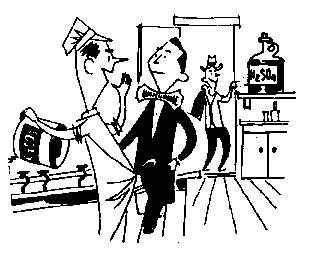
Curated with aloha by
Ted Mooney, P.E. RET

The authoritative public forum
for Metal Finishing 1989-2025

Thread 352/58
Alternate Hard Chrome Mixed Catalyst
Q. Hello, I'm looking into using a generic "hydrofluosilicic acid" fluoride catalyst instead of a proprietary liquid catalyst. We use approx. 7 gallons a day due to caustic cleaner drag in (forms NaF solids on bottom). Will the "generic" catalyst react differently to NaOH drag in? Does any one have experience in converting, operating and the properties of "generic" mixed catalyst hard chrome baths? How can the active fluoride catalyst be analyzed?
Thanks
chrome plater - New York
2005
publicly reply to T Deakin
A. My first question is why not take steps to reduce or eliminate the drag over of alkali? Second, the so called generic catalyst is one which you would have to research the formulation of and be responsible for control and service. Further, is that the catalyst family you are using or are you using one of the just off patent MSA based materials. It does matter. Using a home brew fluoride catalyst in hard chrome can, if done wrong, result in pitting.
Gene Packmanprocess supplier - Great Neck, New York
2005
publicly reply to Gene Packman
A. Hi folks, please take this opportunity to enjoy the classic "poem" "Chemical Balance" as a reminder that self regulating fluoride catalyst is supposed to form solids on the bottom.
Regards,

Ted Mooney, P.E. RET
Striving to live Aloha
finishing.com - Pine Beach, New Jersey
publicly reply to Ted Mooney
Q. Thanks Gene,
We have tested removing (rinsing)caustic cleaner from low alloy steel (1045) portion of engine valves above hard chrome solution. The results have always resulted in rusting on the valve seats above hard chrome. We have investigated air blow off of caustic cleaner with no success on our automatic equipment. I am open to other ways to protect the low alloy parts from rusting during the hard chrome plate cycle of 10 minutes. We have no problems with rusting on stainless steel valve seats.
We use a soluble mixed catalyst presently, but need to leave a film of caustic cleaner on a portion of our low alloy valves we plate to prevent rust on valve seats. The caustic then binds with the Fluoride to form inactive solids. Raking up these solids doesn't seem to increase the active catalyst. The only way is to add more liquid catalyst.
We have looked into derusting valves seats after chrome plate, but the etching done to substrate is cause for rejection.
Our main goal is to reduce our costs. If we can find a suitable "generic" fluoride catalyst, this will greatly help our operation remain competitive. Any other ideas on how we can overcome this seat rusting issue would be appreciated!
- New York
2005
publicly reply to T Deakin
![]() Interesting situation! I wonder is anyone has ever formulated "all potassium" cleaners?
Interesting situation! I wonder is anyone has ever formulated "all potassium" cleaners?

Ted Mooney, P.E. RET
Striving to live Aloha
finishing.com - Pine Beach, New Jersey
2005
publicly reply to Ted Mooney
Ed. note:
Durachrome 60 appears to be a tradename/trademark of Plating Resources, Cocoa, FL, for a fluoride additive; Durachome 85 appears to be their non-fluoride high-speed additive.
Q. Hi, I need to know how to use Durachrome 60 or 85 type catalyst with standard chroming bath?
AS KhanPlating - Larkana, Sind, Pakistan
October 25, 2016
publicly reply to AS Khan
Q, A, or Comment on THIS thread -or- Start a NEW Thread

